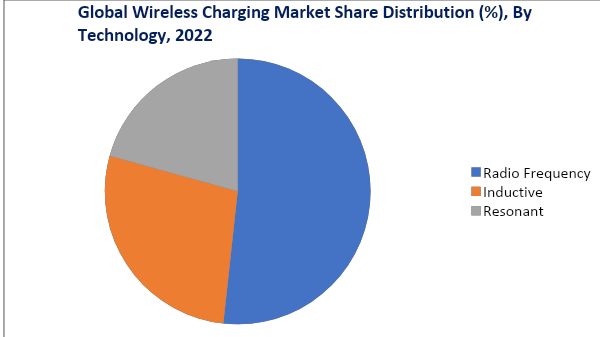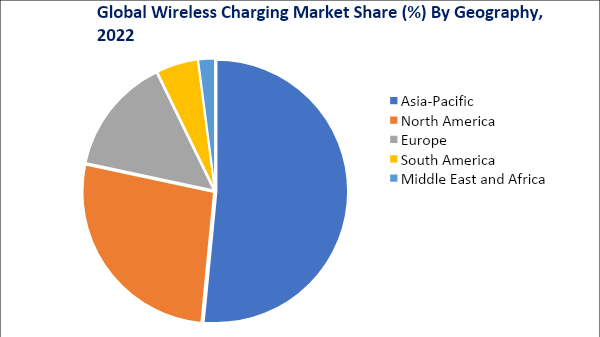Wireless Charging Market Overview
The Global Wireless Charging market to grow at a CAGR Of 27.3% during the forecast period 2024-2031.
Wireless charging enables the wireless transmission of electrical energy from a charging device or node to the recipient device. Wireless charging is known as inductive charging even though it is one of its types or methods. It maintains a constant power supply to ensure that all devices, including wearables, cellphones, and other devices, are charged and available for use. Wireless charging uses a number of different methods, including radio frequency, magnetic, and resonant.
Market Summary
| Metrics | Details |
| CAGR | 27.3% |
| Size Available for Years | 2022-2031 |
| Forecast Period | 2024-2031 |
| Data Availability | Value (US$) and Volume (Tons) |
| Segments Covered | Technology, Component, Application, and Region |
| Regions Covered | North America, Europe, Asia-Pacific, South America and Middle East & Africa |
| Fastest Growing Region | Asia-Pacific |
| Largest Region | Asia-Pacific |
| Report Insights Covered | Competitive Landscape Analysis, Company Profile Analysis, Market Size, Share, Growth, Demand, Recent Developments, Mergers and Acquisitions, New Product Launches, Growth Strategies, Revenue Analysis, Porter’s Analysis, Pricing Analysis, Regulatory Analysis, Supply-Chain Analysis and Other key Insights. |
To know more insights Download Sample
Wireless Charging Market Dynamics
Growing integration of electronic devices in everyday life and demand for convenience and accessories' durability
Wireless charging could be used on portable devices such as wearables, smartphones, and laptops in addition to relatively large electronic appliances and devices like electric and hybrid cars, medical supplies, and other adaptable appliances and gadgets that typically charge at power levels below 100 watts. With wireless charging, there is no electrical interaction between the gadget and the technology. There is no longer a requirement to insert a wire into a charging port as a consequence. Frequent plugging and unplugging can harm the charging terminals on the devices and the charging cables. A wireless charging method including Apple's MagSafe Charging that mechanically adheres to a device reduces wear and tear even more. Thus, the increasing use of electronic devices in daily living and consumer desire for comfort and long-lasting accessories drive growth and consumption in the global wireless charging market.
The expensive price of wireless charging goods relative to wired charging
Devices that include wireless charging as an add-on feature are quite expensive due to the added complexity and expense of manufacturing. Moreover, they will need specialized accessories like a charging stand or mount that are much more costly than cable charges. Both the device and the attachment need motor circuits and magnets. Therefore, the expensive price of wireless charging goods relative to wired charging restraints the market growth. However, it is anticipated that the cost of wireless charging gadgets will decrease as technology advances.
Wireless Charging Market Segmentation Analysis
The global wireless charging market is segmented based on technology, component, application and region.
Growing R&D investments and increasing industrial applications of wireless charging
Electromagnetic induction is presently the most common recharge technique. Wireless charging using magnetic resonance can provide up to 11kW to devices that require a lot of energy. One adapter can power multiple devices at once using this wireless charging method. It is the most flexible form of wireless charging and is used for devices like electric vehicles, laptops, and vacuum cleaners. Magnetic resonance technology is provided by the businesses Energizer, WiTricity, and Infineon. In May 2020, the China Electricity Council revealed a set of national regulations for wirelessly charging electric cars. These regulations were based on the magnetic resonance charging innovation developed and copyrighted by WiTricity.

Wireless Charging Market Geographical Share
Growth in the new generation of electric vehicles and rising smart device usage in Asia-Pacific
Asia-Pacific is expected to account for the largest market share over the forecast period. New electric car sales and smart device usage are on the rise, which are the two main market drivers in the Asia-Pacific region. In China and India, there is tremendous promise for the automotive and electronic sectors. In China, the world's center for car manufacturing, the growth of the wireless charging industry holds a lot of potential. In the future years, China is also expected to overtake other countries as a significant producer of electrical equipment. Well-known manufacturers like HTC, Panasonic, LG, Lenovo, Samsung, and Sony have major production facilities in the Asia-Pacific region.
Furthermore, as the market for wireless power charging expands, local producers are concentrating more on developing cutting-edge ICs that are more compact and effective at transmitting energy. For instance, Samsung declared the launch of the wireless power bank and wireless charging duo pad in 2021 to expand its line-up in the wireless environment.

Wireless Charging Companies
The major global players include Qualcomm Technologies, Inc, Ubeam, Toshiba Electronic Devices and Storage Corporation, Powermat, Integrated Device Technology, Inc., Semtech, Powercast Corp, Witricity Corporation, Tdk Corporation, and Samsung Electronics Co., Ltd., among others.
Key Developments
- WiTricity, the pioneer in wireless charging, announced that it will start selling an upgrade package for some electric cars on February 23, 2022. A smooth, end-to-end charging procedure is provided by the WiTricity Halo wireless charging system.
- WiTricity completed a fresh US$ 63 million funding round on August 9, 2022. Along with Japan Energy Fund and Mirae Asset Capital, the round also includes new backers Stage One, Airwaves Wireless Electricity, and Delta Electronics, as well as a US$ 25 million investment from industrial giant Siemens AG. The company intends to create wireless charging technologies and product lines, building on the global growth of EV usage, backing for electrification from governments around the world, and the recognized need for improved EV charging solutions.
- On January 13, 2021, Samsung Electronics Co., Ltd. revealed the arrival of two new wireless charging devices. The EP-P4300 is the first item and provides 9W rapid wireless charging for cell phones and 3.5W wireless charging for wearables. Using the Samsung Wireless Charger Pad Duo EP-P4300, you can concurrently power a watch and a smartphone. The Wireless Charger EP-P1300, the second product, provides Samsung smartphones with 9W of fast wireless charging, but only 7W for Apple iPhones. Based on their characteristics, the EP-P4300 was marginally more expensive than the EP-P1300.
Why Purchase the Report?
- To visualize the global wireless charging market segmentation based on technology, component, application and region, as well as understand key commercial assets and players.
- Identify commercial opportunities by analyzing trends and co-development.
- Excel data sheet with numerous data points of wireless charging market-level with all segments.
- PDF report consists of a comprehensive analysis after exhaustive qualitative interviews and an in-depth study.
- Product mapping available as Excel consisting of key products of all the major players.
The global wireless charging market report would provide approximately 61 tables, 58 figures and 193 Pages.
Target Audience 2024
- Manufacturers/ Buyers
- Industry Investors/Investment Bankers
- Research Professionals
- Emerging Companies